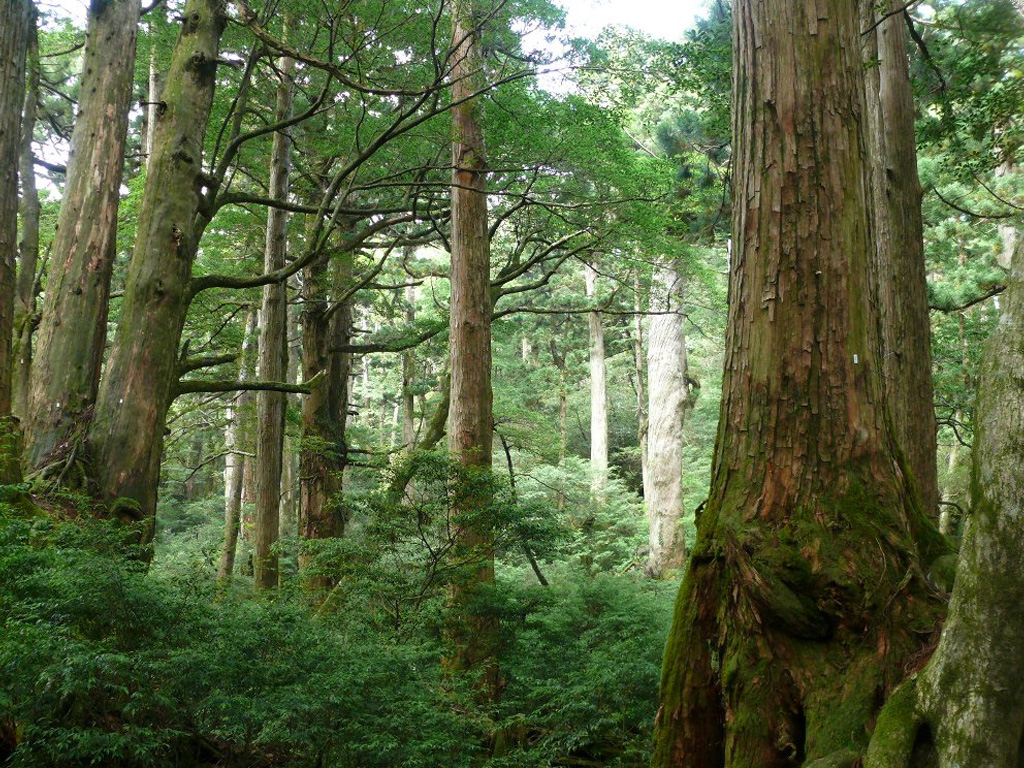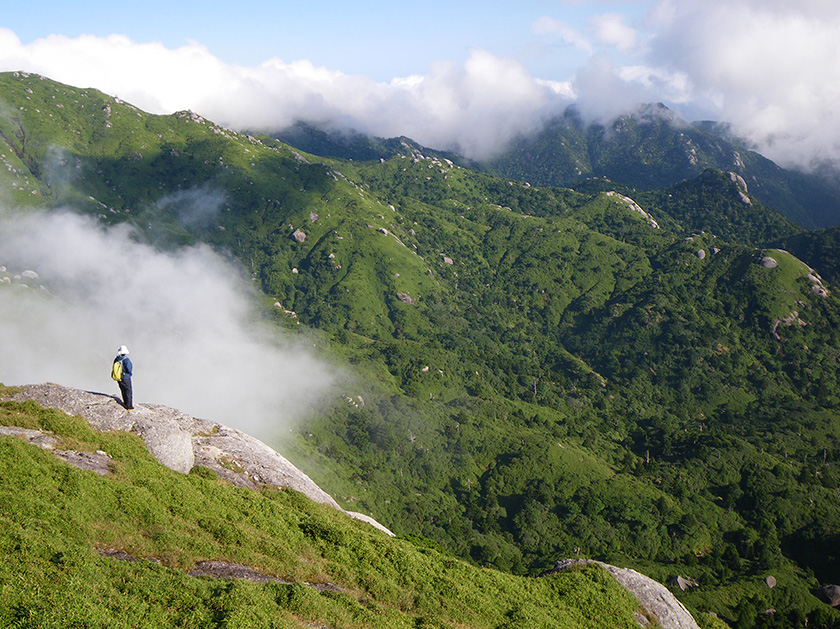The Path to World Natural Heritage Registration
Registered as Japan's First World Natural Heritage Site.
Yakushima Island was registered as the first World Natural Heritage site in Japan along with Shirakami Sanchi on December 11, 1993. Approximately 10,747 ha of Yakushima Island, 20% of the total area of the island, is registered as part of the natural heritage site.
Reasons for Nomination
Yakushima Island is mountainous with high peaks, notably Mt. Miyanoura (1,936 m), the highest peak in Kyushu, in the center. As a high peak in a humid climate located in the global transition zone for animals and plants, it is in a biogeographically unique environment, and blessed with heavy annual rainfall of 4,000 to 10,000 mm.=== Its forest vegetation is particularly unique, and includes Yaku-sugi Cedars thousands of year old. The island has a prominent vertical distribution of vegetation extending from subtropical (Malayan banyan and sea fig trees etc.) near the seaside to warm temperate (Japanese bay tree, chinquapin, Japanese oak etc.), temperate (momi fir, trochodendron etc.), and subalpine (pseudosasa owatarii, rhododendron), and much native vegetation, and vegetation at northern and southern distribution limits, grows wild forming a unique ecosystem. Particularly outstanding natural specimens are the Yaku-sugi, Cedars. With a diameter of 3 - 5 m, and thought to be several thousands of years old, this natural forest of massive trees is considered precious on an international scale for its ecology and morphology. Various animals and vegetation in danger of extinction, including the Ryukyu robin and the Izu thrush (vulnerable species) inhabit this area.


Japanese Evaluation for Registration
Approximately 10,747 ha, 20% of the island's total area, is registered as a Natural Heritage site.
In addition to a national park and part of a forest biosphere reserve, the area encompasses a wilderness area and a nationally designated natural monument (Yakushima Primeval Cedar Forest) and includes an evergreen broad-leaf forest zone, subtropical elements near the coast line, a mountain area cedar forest zone, and a pseudosasa owatarii grassland zone. When Yakushima Island was registered as a World Heritage site, UNESCO World Heritage Center Director Bernd von Droste noted that its value as natural heritage site is that it has retained its outstanding natural environment despite the presence of its many human inhabitants.
Protective Measures Related to Registration
- Wilderness area
- National park
- Special natural monument
- Forest biosphere reserve
Steps to Registration
- 1922Designated as a protected forest for academic reference.
- Dec. 9, 1924 A protected forest for academic reference designated as a natural monument (Yakushima Primeval Cedar Forest).
- Mar. 20, 1954 Natural monument (Yakushima Primeval Cedar Forest) designated as a special natural monument.
- Mar. 16, 1964Yakushima Island designated as part of the Kirishimayaku National Park.
- 1967Discovery of Jomon-sugi Cedar reported in Minami-Nippon Shimbun newspaper.
- May 17, 1975Part of national park designated as wilderness area.
- Feb. 17, 1981National park and wilderness area designated as biosphere reserve based on the UNESCO Man and Biosphere Program.
- Jan. 14, 1983National park expanded to include Segire River and Nagata River basins.
- Oct. 1990'Super Nature Yakushima' Forest Utilization Plan formulated by Kamiyaku Town.
- 1991Yakushima Environment and Culture Council established.
- Mar. 13, 1992 Cabinet decision to submit Treaty to Diet.
- Mar. 30, 1992 Protected forest for academic reference designated as Yakushima Forest Biosphere Reserve by incorporating several areas, including the central mountain, western, and southern areas, and the natural recreation forest.
- Jun. 30, 1992 Japanese government sends written acceptance of Treaty to UNESCO.
- Oct. 1, 1992Yakushima Island recommended to World Heritage Committee.
- Nov. 1992The Yakushima Environmental and Cultural Village Concept Master Plan formulated by Kagoshima Prefecture.
- Mar. 1993The Yakushima Environmental and Cultural Foundation established by Kagoshima Prefecture, Kamiyaku Town, and Yaku Town .
- May 16-18, 1993Site-inspection conducted by International Union for Conservation of Nature (IUCN).
- Jun. 25, 1993Bureau Meeting held by World Heritage Committee.
Report submitted by IUCN recommending registration of Yakushima Island. - Aug. 11, 1993World Heritage Center Director sends results of meeting.
Decision to recommend registration sent to World Heritage Committee. - Oct. 1993Yakushima Charter adopted by Kamiyaku Town and Yaku Town.
- Dec. 6-11, 1993 World Heritage Committee meeting (Cartagena, Colombia).
Yakushima Island and Shirakami-Sanchi recorded on World Heritage List as natural heritage sites. Buddhist monuments in the Horyu-ji Temple area and Himeji Caste recorded on List as cultural heritage sites (officially registered Dec. 11).
Developments Following Registration
- Sep. 1995Yakushima World Heritage Area Liaison Committee established consisting of related parties from Environmental Agency, Forestry Agency, and Kagoshima Prefecture etc.
- Nov. 1995 Yakushima World Heritage Area Management Plan formulated by Ministry of the Environment, Forestry Agency, and Agency for Cultural Affairs.
- Apr. 1996 Yakushima World Heritage Conservation Center opened.
- Oct. 18-20, 1997 IUCN Status of Management Survey.
- Oct. 1998 Symposium held on Yakushima Island to commemorate 5th anniversary of registration of Yakushima Island as a World Natural Heritage site.
- Dec. 1998World Heritage Committee meeting held in Kyoto.
- May 2000 World Natural Heritage Conference held in Kagoshima City and on Yakushima Island.
- Feb. 19, 2002National Park expanded to include eleven areas including Shirataniunsui-kyo Ravine, Nagata Beach, and surrounding sea.
- Oct. 2005Second World Natural Heritage Conference held in Aomori City and Shirakami-Sanchi.
- Nov. 8, 2005Yakushima Island's Nagata Beach (Maehama Beach, Inaka Beach, and Yotsuse Beach) registered as wetlands under the Ramsar Convention.
- Mar. 30, 2007 Entire Kuchinoerabu-jima Island and surrounding seas added to national park.
- Jun. 2009Yakushima Island World Heritage Area Scientific Council established.
- Oct. 2010Yakushima Deer Working Group established.
- Mar. 16, 2012Kirishimayaku National Park restructured and Yakushima Island National Park newly designated.
- Oct. 2012
Revised Yakushima World Heritage Area Management Plan formulated by Ministry of the Environment, Forestry Agency, Agency for Cultural Affairs, Kagoshima Prefecture, and Yakushima Town .
- Oct. 20, 2013
Symposium held in Tokyo to commemorate 20th anniversary of registration of Yakushima Island as a World Natural Heritage site.
- May 2014 Yakushima World Heritage Conservation Center reopened after renovation.

